Hyundai Kona Electric Review 2025: Price, specs & boot space
Written by Ivan Aistrop
Quick overview
Pros
- Comfortable and easy to drive
- Impressive range of up to 319 miles
- Spacious, user-friendly interior
Cons
- Likes to bong and beep to the point of distraction
- Bold design won't be to everyone's taste
- Faces stiff competition from China
Verdict: Is the Hyundai Kona Electric a good car?
"As it enters its second generation, the Hyundai Kona Electric has gained a bit of swagger. While the old model was good, this new version combines a roomier interior with striking looks and one of the longest electric ranges available in a small electric SUV. There's a lot to like but - in a market that's growing at a rapid rate - does the Kona Electric remain at the top of the class? Find out in our 2025 Hyundai Kona Electric review."
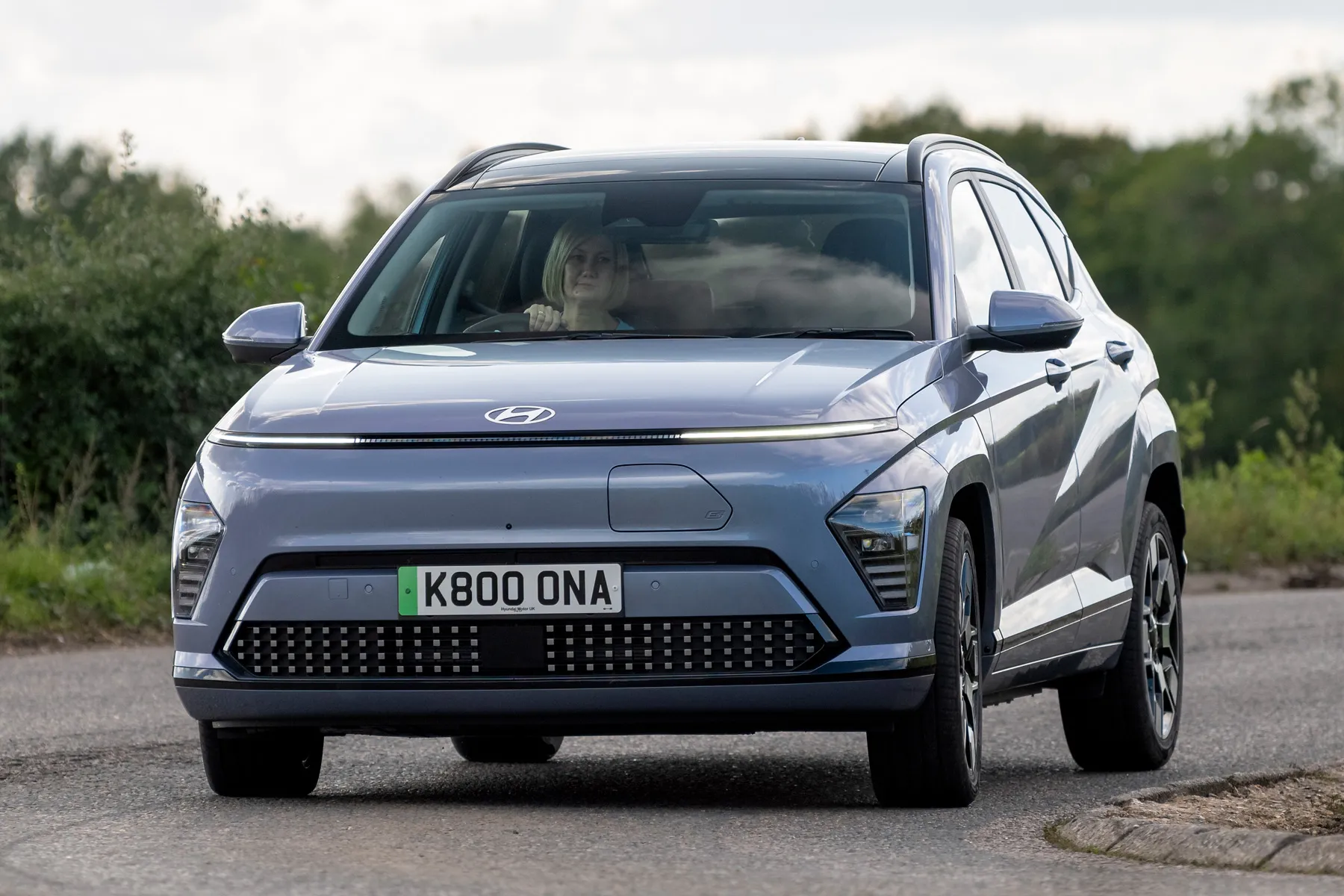
Remember when the old Hyundai Kona Electric went on sale in 2019? Back then, it didn't have a great deal in the way of competition, and its affordable price tag combined with a very useable range meant it was a very desirable electric car. It proved to be so popular, in fact, that Hyundai had to take it off sale in the UK because waiting lists were spiralling out of control.
So here we are, then, with the difficult second album. And just look at it. There's nothing bland about the way the new Kona Electric looks: from its futuristic light bars to its angular wheel arches, this is a car that isn't in danger of blending in.
It's grown in size, too, which means there's much more interior space than before. You could comfortably use the new Hyundai Kona Electric as your main family car, something we wouldn't have said about its predecessor, nor rivals like the Jeep Avenger or Peugeot e-2008.
Initially, the cheapest Hyundai Kona Electric used a 48kWh battery pack, which provided a range of up to 234 miles, but this option has now been discontinued. That's because most buyers went for the bigger 65kWh battery, with its range of up to 319 miles. That's the kinda range that'll tempt even the most reluctant EV buyer away from their petrol or diesel car.
There are a few other little features that make the Hyundai Kona Electric easier to live with, too. It can be rapid charged at a range of up to 102kW, adding 100 miles of range in as little as 15 minutes. And the standard-fit heat pump gives it the edge over the Kia Niro EV, adding some welcome efficiency over the winter months.
Buyers get a choice of four trim levels, ranging from Advance to Ultimate with the sporty N Line and N Line S models sitting in the middle. All are well-equipped, although you'll need one of the higher-spec models for the most comprehensive amount of safety kit.
All in all, the new Hyundai Kona Electric is a cracking little car and should definitely be on your electric SUV shortlist.
Looking for a used car for sale? We've got 100s of Hyundai Approved Used Cars for Sale for you to choose from, including a wide range of Hyundai Kona Electric cars for sale. Looking for the older version? You need our used Hyundai Kona Electric (2019-2023) review.
Is the Hyundai Kona Electric right for you?
The Hyundai Kona Electric remains one of the best electric SUVs you can buy. It feels more grown up than its predecessor, but its bold looks mean it can't be accused of following the crowd. If you want a comfortable and spacious electric SUV with an impressive electric range, the Hyundai Kona Electric is an excellent choice.
What’s the best Hyundai Kona Electric model/engine to choose?
Buy the highest-spec model you can afford. While the bigger battery won't be necessary for a lot of used buyers, it's all that's now available on the new car market, and the extra range and performance is welcome. The entry-level Kona Electric Advance is missing some desirable features (such as heated seats and a wireless phone charger): if budget allows, the Hyundai Kona Electric Ultimate is a very appealing SUV.
What other cars are similar to the Hyundai Kona Electric?
Don't buy a Hyundai Kona Electric without also looking at the Kia Niro EV. The Kia is a more sensible, staid alternative to the Kona, with slightly more interior space and - as it's been on sale for longer - more tempting deals available on the used market. Other desirable small electric SUVs include the Smart #1, BYD Atto 3, Renault Megane E-Tech, Volvo EX30, along with the Jeep Avenger, Peugeot e-2008 and Vauxhall Mokka Electric.
Volkswagen Group's electric cars are also worth a look, particularly the practical Skoda Enyaq iV and the stylish Volkswagen ID.3 or ID.4 SUV. If you like the Hyundai Kona Electric but would prefer something a little bigger, we'd recommend the excellent Hyundai Ioniq 5.
Comfort and design: Hyundai Kona Electric interior
"The new Hyundai Kona Electric's cabin is unrecognisable from that of its predecessor. It's more mature and grown up, helped by the impressive technology that's fitted as standard on even the most affordable models."
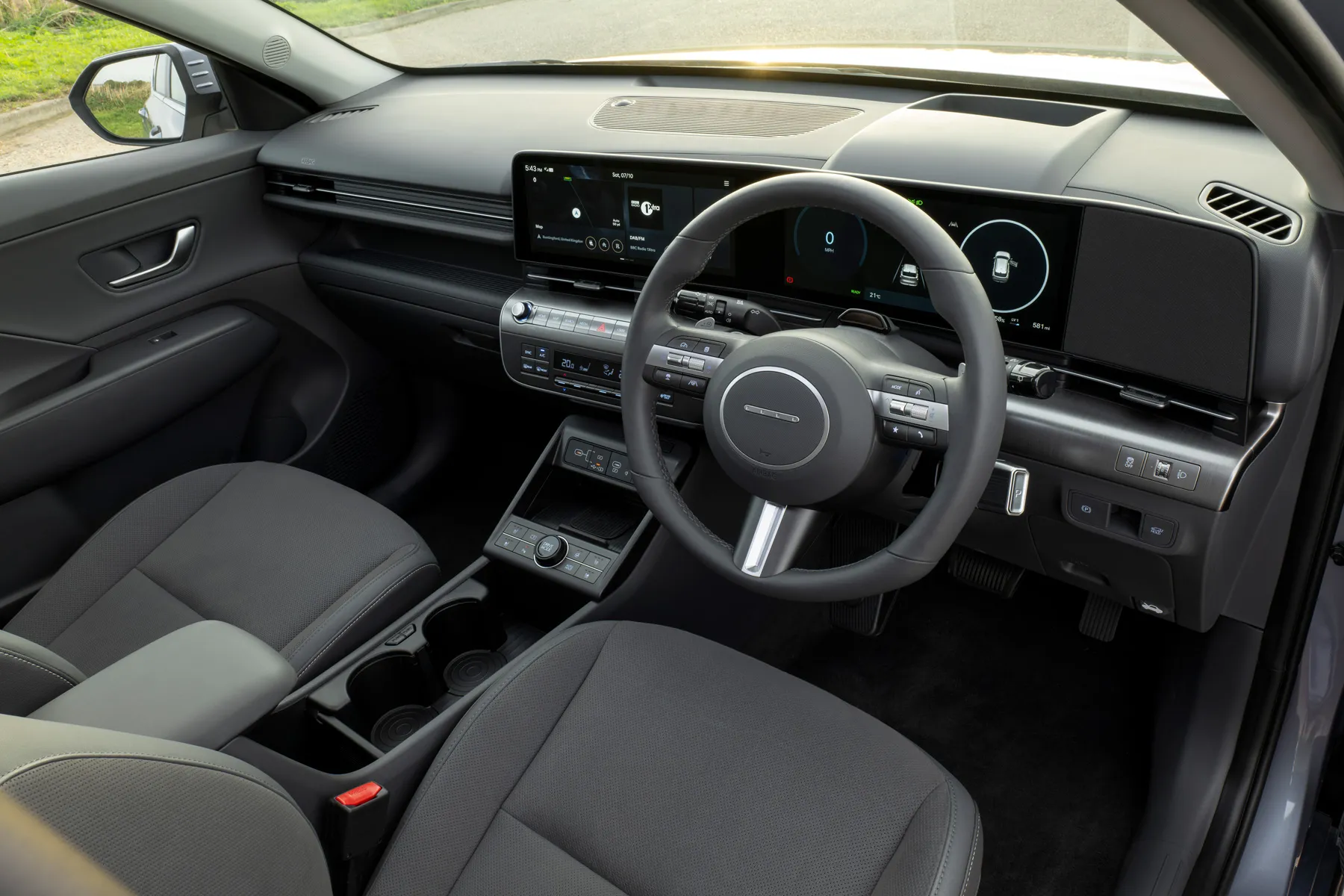
It feels like there's a lot more space inside the new Hyundai Kona Electric, thanks partly to increased dimensions, but also due to thinner seats and a narrower centre console.
While the infotainment remains the same no matter which Kona Electric trim level you go for, the rest of the cabin is pretty spec-dependent. N Line and N Line S models come with sporty aluminium pedals, for example, while the latter also comes with part-Alcantara and leather seats.
Minimalists will hate the button-heavy dashboard, but we think it's pretty user-friendly. It might not look as modern as the haptic controls found in some rival cars, but we like the ability to adjust the climate control without being distracted from the important business of driving by the touchscreen.
Most drivers will be able to get comfortable pretty quickly in the Kona Electric. There's a wide range of adjustment in both the seats and steering column, while the driver's seat gets adjustable lumbar support as standard.
Quality and finish
If you're looking for a posh electric SUV, we'd recommend looking at the Volvo EC40 or BMW iX1 instead. But the Hyundai Kona Electric certainly feels well screwed together, and a step above budget models like the MG ZS EV.
Infotainment: Touchscreen, USB, nav and stereo in the Hyundai Kona Electric
The centrepiece of the Hyundai Kona Electric's interior is the wide 12.3-inch navigation screen, which sits alongside another 12.3-inch LCD digital instrument display behind the steering wheel. It all looks suitably modern but the car isn't too heavily reliant on touchscreen operation: there's a useful bank of physical shortcut buttons positioned below the main screen.
The infotainment system is easy to navigate, while Apple CarPlay and Android Auto are on hand to provide access to your favourite apps on the move. All Hyundai Kona Electric grades but the entry-level Advance get a wireless phone charger, while you'll need an N Line S or Ultimate model for the desirable BOSE premium sound system.
Space and practicality: Hyundai Kona Electric boot space
The Hyundai Kona Electric is a fair bit bigger than before, meaning it's now practical enough to use as your main family car, rather than simply as an urban runaround. It measures 4350mm in length, 1825mm wide and 1575mm high, while luggage capacity has increased to 466 litres.
It certainly feels pretty spacious up front, while those in the back will have more room than they would in a Smart #1 or Jeep Avenger. There's a flat floor in the back, too, meaning middle-seat passengers won't be struggling for somewhere to put their feet.
While the boot isn't quite as big as the Kia Niro EV's, it's still a very handy size, while an adjustable boot floor reduces the amount of lip that you need to lift items over. If you need more space, the rear seats are split 40:20:40 (on N Line models and above), dropping to provide up to 1300 litres of luggage space.
Handling and ride quality: What is the Hyundai Kona Electric like to drive?
"The Hyundai Kona Electric is the ultimate car for people who don't really care about driving fun and just want to go about their business with minimal fuss."
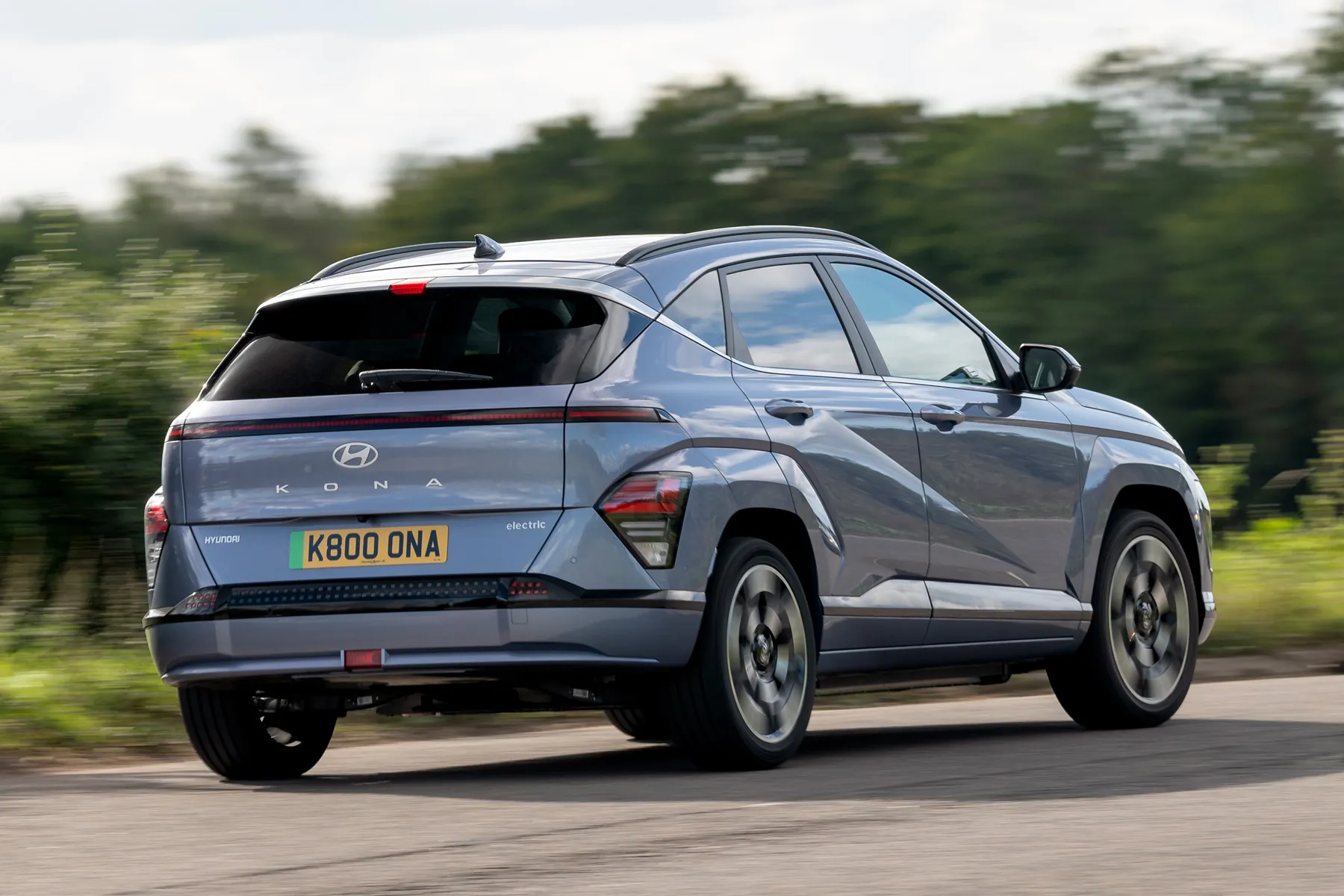
It's exceptionally easy to drive, helped by an extensive (and almost irritating) amount of driver-assistance features. You'll soon learn how to turn some of these off (the bongs every time the speed limit changes are particularly annoying) but, that aside, the Kona Electric is the perfect companion for almost any journey.
The Hyundai Kona Electric is pretty softly sprung, meaning it rides well over broken road surfaces but things do get a little floaty at speed. We've only tried the Kona Electric on 19-inch alloy wheels, which are fitted as standard to most of the range. Go for the entry-level model with the 17-inch wheels, and we suspect it'll be even more comfortable at dealing with low-speed imperfections in the road.
One of our favourite features of a lot of electric vehicles is regenerative braking. This uses the electric motor to slow the car down in a more efficient way than applying the friction brakes. It works particularly well in the Kona Electric, with paddles behind the steering wheel to adjust the amount of regen. With it ramped up to the max, the Kona Electric can be brought to a stop entirely without touching the brake pedal: with a bit of practice, it's useful around town.
What motors and batteries are available in the Hyundai Kona Electric?
Initially, the most affordable Hyundai Kona Electric came with a 'standard range' 48kWh battery pack powering a single electric motor driving the front wheels. This produces 156PS and takes the Kona Electric from 0-62mph in 8.8 seconds: not particularly speedy, but more than adequate for a sensible little SUV like this. That powertrain option has now been withdrawn from factory ordering, though, so if you want it, you'll have to look to the used car market.
The 'long range' model was always more popular, with its bigger 65kWh battery pack and increased performance. With 218PS, this accelerates to 62mph a second quicker than the regular car. It's still not Tesla quick, but the Kona Electric feels pretty sprightly: it certainly has more urgency than, say, the Jeep Avenger.
Hyundai Kona Electric range: How far can you travel on a charge?
Even if you buy a Hyundai Kona Electric with the smaller 48kWh battery pack, official WLTP tests suggest you should be able to travel 234 miles between charges. The bigger battery model has an official range figure of up to 319 miles: that's an impressive distance for a relatively affordable electric vehicle. Do bear in mind, though, that this figure drops to 282 miles in the N Line and N Line S versions due to their larger 19-inch alloy wheels
Of course, the Hyundai Kona Electric's real-world range depends on factors like how it's driven and even the weather conditions. A heat pump is standard, though, meaning the Hyundai Kona Electric should be more efficient in winter than many other electric cars (such as the Kia Niro EV) that aren't fitted with one.
Compared to rivals, the Hyundai Kona Electric performs very well in terms of range. For comparison, the most a Kia Niro EV can manage is 285 miles, the Smart #1 can cover 273 miles, while the Jeep Avenger is limited to 248 miles. If you need to travel further on a charge, you'll be looking at some of the longest range electric cars like the Tesla Model 3.
Refinement and noise levels
While there's a slight whine from the electric motor, the Hyundai Kona Electric is generally exceptionally refined. You won't notice a huge amount of wind- or road noise, and it's certainly a much more relaxing small SUV than any petrol or diesel alternative.
Safety equipment: How safe is the Hyundai Kona Electric?
The crash safety bods at Euro NCAP have smashed the Kona Electric to smithereens and concluded that it's generally a pretty safe car, awarding it a four-star safety rating. It lost marks for the performance of its safety assist features, which is surprising considering the sheer amount of beeps and bongs you'll notice when driving the Kona.
Standard safety equipment across the Hyundai Kona Electric range includes a driver status monitor (which constantly monitors the driver's face and warns you to pay attention or take a break when necessary), as well as Lane Keep Assist (LKA), Intelligent Speed Limit Assist (ISLA), Manual Speed Limit Assist (MSLA), Forward Collision Avoidance Assist (FCA 1.5), Rear View Monitor (RVM), Lane Following Assist (LFA), Highway Drive Assist (HDA) 1.5 and Hyundai's eCall system.
High-spec Kona Electric models also come with a Surround View Monitor, Blind Spot Collision Avoidance Assist (BCA) and Blind Spot View Monitor (BVM).
Hyundai Kona Electric charging times: How much does it cost to charge?
"Charging the Hyundai Kona Electric is as easy as plugging in your iPhone. Simply open the flap at the front of the car, connect a charging lead and leave it to it."
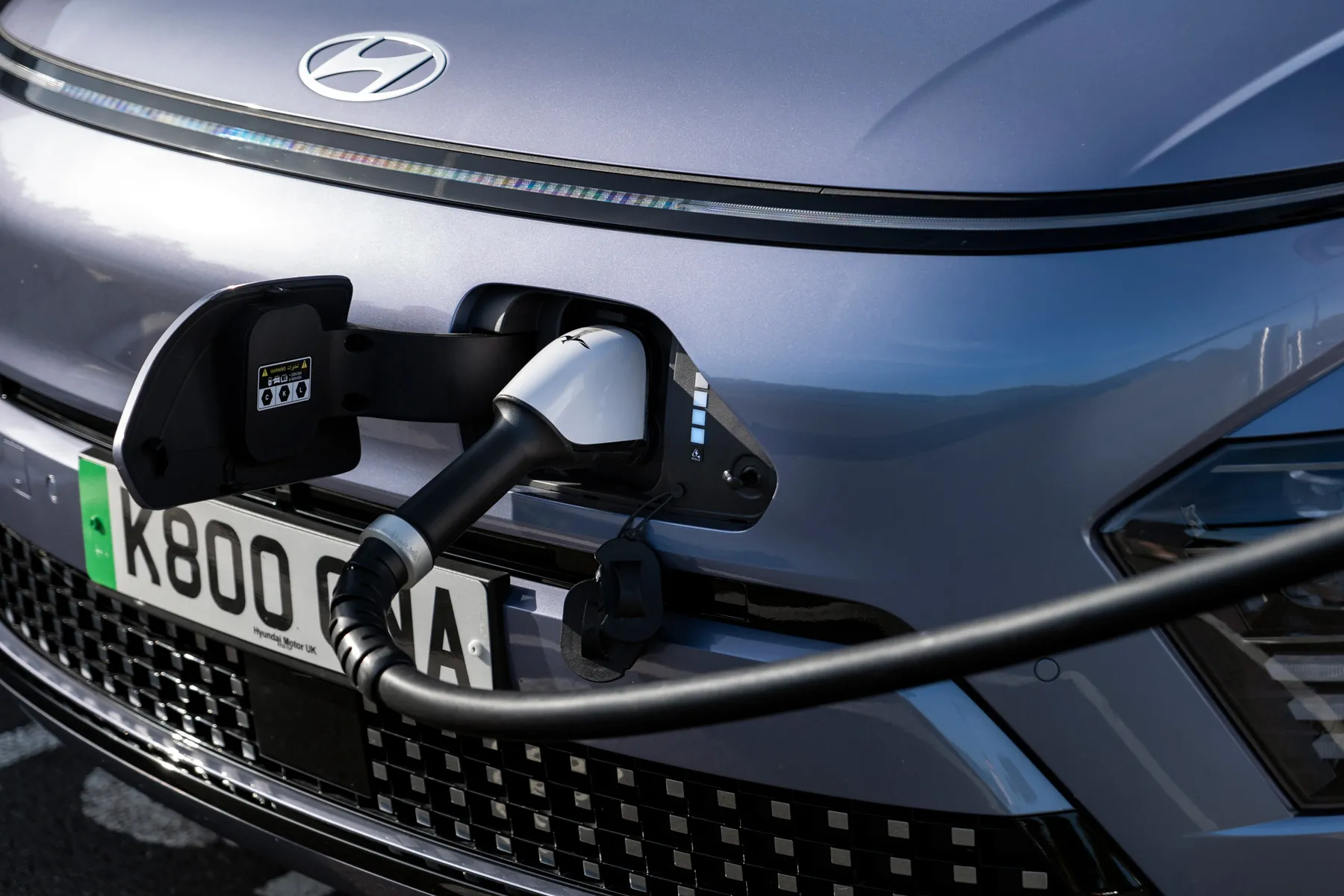
We'd always recommend having a 7kW wallbox installed for easy home charging: it's the quickest and most efficient way of topping up the car at home. Connect the Kona Electric to one of these and it will take around eight hours to fully charge (or six hours for the smaller battery model), at a cost of around £15 to £20 depending on your electricity tariff. For even cheaper electric car charging, it's worth looking into tariffs with cheaper overnight rates: getting yourself on one of these could save a significant amount of money.
If you need to travel further than the Hyundai Kona Electric's range, a rapid charger will provide a welcome top up in the time it takes you to grab a coffee. That's because it can charge at a rate of up to 102kW (that's quicker than the old Kona Electric or the latest Kia Niro EV), adding 100 miles of range in just 15 minutes. You'll pay for the convenience, with most rapid chargers costing somewhere in the region of 85p per kWh, meaning a 70% charge could hit your wallet by as much as £40. That's still less painful than refuelling a petrol car at the motorway services, but not by that much.
Hyundai Kona Electric reliability and warranty
Hyundai has an excellent reliability record, especially with its electric vehicles, so we have no doubt that the new Hyundai Kona Electric will be a totally dependable choice. In the latest 2025 edition of the HonestJohn.co.uk Satisfaction Index - put together by our excellent sister website - Hyundai came 10th out of 33 carmakers in the manufacturer standings for reliability, while the previous Kona was voted as the 5th most reliable car in the entire study, making it Hyundai's best-performing model.
If that doesn't put your mind at rest, the Hyundai Kona Electric comes with the brand's five-year, unlimited-mileage warranty, including five years of roadside assistance and five years of vehicle health checks. The battery, meanwhile, is covered for eight years or 100,000 miles.
Hyundai Kona Electric insurance groups and costs
If you buy a used Kona with the smaller battery, then your car will slot into insurance group 25 (of 50, with group 50 cars being the most expensive to insure). So, expect middling premiums on that one.
The 65kWh version sits in group 31 when specified in Advance and N Line trims, or 32 in N Line S trim and 33 in Ultimate trim.
VED car tax: What is the annual road tax on a Hyundai Kona Electric?
Gone are the days when buying an electric car would allow you to swerve VED tax: EVs now face the same annual costs as all other types of car. The standard flat rate for all cars built since 2017 is currently charged at £195 per year.
Cars that cost over £40,000 when brand new are also liable for the luxury car surcharge, which adds another £425 per year on top of that flat rate for a five-year period between years two and six of the car's life. Currently, no version of the Kona Electric costs more than that threshold, but a couple of higher-end versions get close, and adding a few optional extras could take you over the threshold, lumbering you - or the car's next owner - with liability. If buying used, it's always a good idea to Google the reg of your prospective purchase to find out what you're letting yourself in for.
Hyundai Kona Electric price
"With prices for a brand new Hyundai Kona Electric starting from £35,000, it undercuts the Kia Niro EV, Smart #1 and BYD Atto 3, although the MG Z5 EV is even cheaper. Prices rise to more than £39,000 at the top of the range."
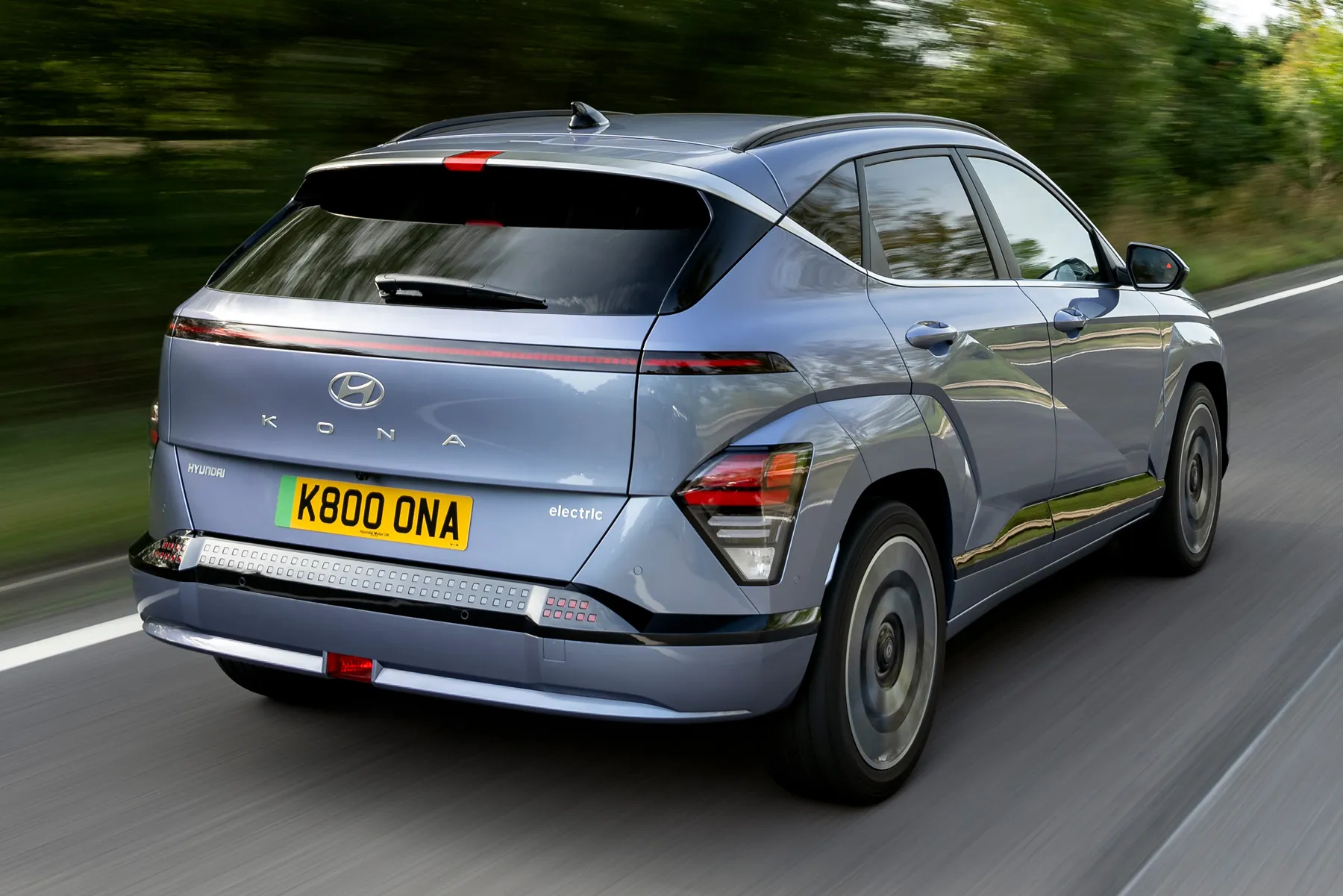
As ever, though, some tremendous savings can be made by hitting the used car market instead. Browse the heycar listings and you'll find prices starting at around £21,000. These are mainly basic Advance cars from 2024, so will have most of the original warranty left, and both powertrain options are available for the money. Most should have a low four-figure mileage, too.
Trim levels and standard equipment
The range kicks off with the Hyundai Kona Electric Advance. Spec highlights include 17-inch alloy wheels, dual-zone climate control, smart cruise control, a heat pump, front- and rear parking sensors, keyless entry and a three-pin internal plug.
The Hyundai Kona Electric N Line is a sportier choice, with 19-inch alloys, privacy glass and N Line cloth interior trim. The front and rear seats are heated in the Kona Electric N Line, as is the steering wheel. The N Line also comes with an electric tailgate.
Building on this, the Hyundai Kona Electric N Line S adds electric adjustment for the front seats, N Line Alcantara and leather trim, ventilated front seats, a head-up display, BOSE premium sound system and a range of driver-assistance tech (including Blind Spot Collision Avoidance Assist, Surround View Monitor and Blind Spot View Monitor).
The Hyundai Kona Electric Ultimate builds on the Advance trim with an opening sunroof, part-eco-suede-and-leather upholstery, heated front- and rear seats, ventilated front seats, an electric tailgate, and BOSE premium sound system with seven speakers and a subwoofer. The Kona Electric Ultimate also adds the Blind Spot Collision Avoidance Assist, Surround View Monitor and Blind Spot View Monitor.
Ask the heycar experts: common questions
What is the real-world range of a Hyundai Kona Electric?
How long will the Hyundai Kona Electric's battery last?
Is the Hyundai Kona Electric a good electric car?
Hyundai Kona Electric Alternatives
Get our latest advice, news and offers
Keep me updated by email with the latest advice, news and offers from heycar.
By submitting you agree to our privacy policy




